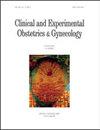Association Analysis of Free Thyroid Hormones, Subclinical Hypothyroidism, and Thyroid Peroxidase Antibody in the First Trimester with Gestational Diabetes Mellitus
IF 0.6
4区 医学
Q4 OBSTETRICS & GYNECOLOGY
引用次数: 0
Abstract
Background: We aimed to investigate the association of free thyroxin (FT4), free triiodothyronine (FT3), subclinical hypothyroidism (SCH), and thyroid peroxidase antibody (TPOab) in the first trimester with gestational diabetes mellitus (GDM). Methods: We recruited 110 pregnant women with GDM and 100 pregnant women without GDM who had normal 75 g oral glucose tolerance test (OGTT) results between June 2019 and June 2021. We collected basic data from all participants and compared serum FT3 and FT4 levels, SCH, and TPOab (+) incidences in the first trimester between the two groups. We used logistic regression to identify factors that influence the development of GDM. Results: Serum FT3 levels were 4.58 ± 0.78 and 4.61 ±1.42 pmol/L in the GDM group and Control group, while FT4 levels were 9.32 ± 2.54 and 10.24 ± 2.77 pmol/L. The incidence of SCH were 25.5% and 14.0%, while TPO (+) were 20.0% and 10.0%. The GDM group’s FT4 levels were significantly lower than the control group’s, whereas the GDM group’s age, incidence of SCH, and TPOab (+) were significantly higher (p < 0.05). Logistic regression analysis demonstrated that age, SCH and TPO (+) were risk factors for GDM (p < 0.05), the regression equation: logit p = –3.484 + 0.105 (age) + 1.128 (SCH) + 1.294 (TPOab (+)). Conclusions: Our findings suggest that monitoring the changes in FT4 levels, SCH, and TPOab (+) incidence in the first trimester may be useful in predicting the occurrence and development of GDM.妊娠早期游离甲状腺激素、亚临床甲状腺功能减退、甲状腺过氧化物酶抗体与妊娠糖尿病的相关性分析
背景:我们旨在研究妊娠早期游离甲状腺素(FT4)、游离三碘甲状腺原氨酸(FT3)、亚临床甲状腺功能减退(SCH)和甲状腺过氧化物酶抗体(TPOab)与妊娠糖尿病(GDM)的关系。方法:我们招募了110名GDM孕妇和100名非GDM孕妇,这些孕妇在2019年6月至2021年6月期间75 g口服葡萄糖耐量试验(OGTT)结果正常。我们收集了所有参与者的基本数据,并比较了两组妊娠早期血清FT3和FT4水平、SCH和TPOab(+)发生率。我们使用逻辑回归来确定影响GDM发展的因素。结果:GDM组和对照组血清FT3水平分别为4.58±0.78和4.61±1.42 pmol/L, FT4水平分别为9.32±2.54和10.24±2.77 pmol/L。SCH发生率分别为25.5%和14.0%,TPO(+)发生率分别为20.0%和10.0%。GDM组FT4水平显著低于对照组,而GDM组年龄、SCH发生率、TPOab(+)均显著高于对照组(p <0.05)。Logistic回归分析显示,年龄、SCH和TPO(+)是GDM的危险因素(p <0.05),回归方程:logit p = -3.484 + 0.105 (age) + 1.128 (SCH) + 1.294 (TPOab(+))。结论:我们的研究结果表明,在妊娠早期监测FT4水平、SCH和TPOab(+)发生率的变化可能有助于预测GDM的发生和发展。
本文章由计算机程序翻译,如有差异,请以英文原文为准。
求助全文
约1分钟内获得全文
求助全文
来源期刊
CiteScore
0.50
自引率
0.00%
发文量
241
审稿时长
1 months
期刊介绍:
CEOG is an international, peer-reviewed, open access journal. CEOG covers all aspects of Obstetrics and Gynecology, including obstetrics, prenatal diagnosis, maternal-fetal medicine, perinatology, general gynecology, gynecologic oncology, uro-gynecology, reproductive medicine, infertility, reproductive endocrinology, sexual medicine. All submissions of cutting-edge advances of medical research in the area of women''s health worldwide are encouraged.

 求助内容:
求助内容: 应助结果提醒方式:
应助结果提醒方式:


